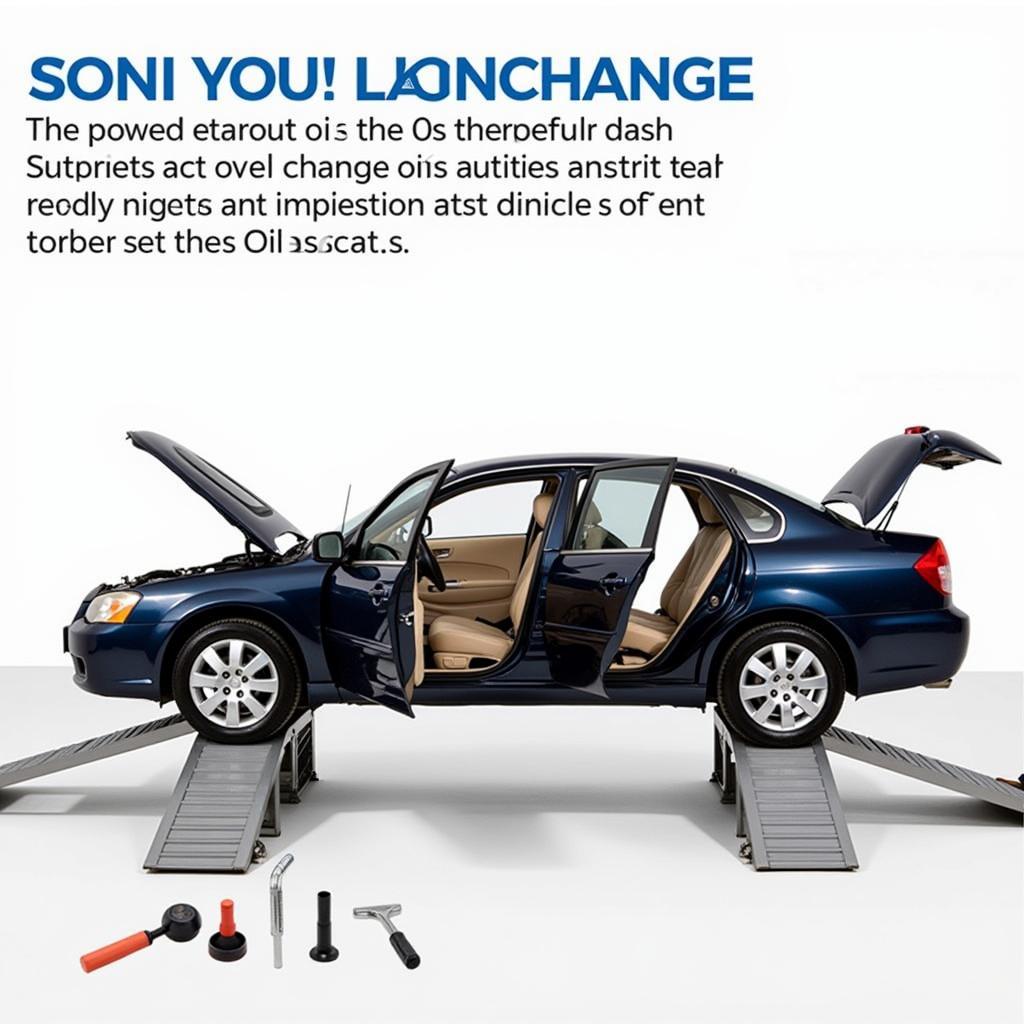Understanding Car Ramp Service: A Comprehensive Guide
Car Ramp Service might sound like a niche topic, but for car enthusiasts and DIY mechanics, it represents a world of possibilities. Whether you’re a seasoned gearhead or a car owner looking to save a few bucks, understanding the ins and outs of car ramps can make all the difference in your maintenance and repair endeavors.
 Car Ramp Types for DIY Service
Car Ramp Types for DIY Service
Why Use a Car Ramp?
Simply put, car ramps elevate your vehicle, providing crucial undercarriage access for a variety of tasks. Unlike jacks, which offer limited lifting points, car ramps provide a stable and secure platform, allowing you to work comfortably and safely underneath your car.
 Using Car Ramps for an Oil Change
Using Car Ramps for an Oil Change
Choosing the Right Car Ramp
Not all car ramps are created equal. Factors such as material, weight capacity, and ramp design play a vital role in determining the right fit for your needs.
- Material: Car ramps come in various materials, including plastic, steel, and aluminum. Plastic ramps are lightweight and affordable but may lack the weight capacity for larger vehicles. Steel ramps are durable and robust, offering high weight limits but can be heavier to maneuver. Aluminum ramps strike a balance between weight and strength, making them a versatile option.
- Weight Capacity: Always check the ramp’s weight capacity to ensure it can handle the weight of your vehicle. Overloading a ramp can lead to dangerous accidents.
- Ramp Design: Consider the ramp’s design, including its incline angle and length. A shallower incline is generally easier to drive up on, while a longer ramp provides more clearance for low-profile vehicles.
Car Ramp Safety Tips
Safety should always be your top priority when using car ramps. Here are some essential safety tips to keep in mind:
- Park on a Level Surface: Always use car ramps on a flat, level surface to prevent the vehicle from rolling off.
- Engage the Parking Brake: Before driving onto the ramps, make sure your car’s parking brake is firmly engaged.
- Use Wheel Chocks: Place wheel chocks behind the rear wheels of your vehicle for an added layer of security.
- Inspect the Ramps: Before each use, inspect the ramps for any signs of damage, such as cracks, bends, or loose parts.
- Drive Up Slowly and Carefully: Drive your vehicle onto the ramps slowly and steadily, keeping the wheels straight.
 Car Ramp Safety Checklist
Car Ramp Safety Checklist
Car Ramp Services: Beyond DIY
While car ramps are excellent tools for DIY car maintenance, they also find extensive use in professional car service settings. Here are some examples of car ramp services:
- Oil Changes: Car ramps elevate the vehicle, making it easier for technicians to access and drain the engine oil.
- Transmission Fluid Service: Similar to oil changes, car ramps simplify the process of draining and refilling transmission fluid.
- Brake Inspections and Repairs: With the car raised on ramps, mechanics have clear access to the brake components for inspection, maintenance, and repairs.
Car Ramp Service vs. Car Lift: Which is Right for You?
Car ramps and car lifts both serve the purpose of raising a vehicle, but they differ in their applications and capabilities. Car ramps are portable, affordable, and well-suited for DIY tasks and basic maintenance in home garages. Car lifts, on the other hand, are heavier-duty, more versatile, and commonly found in professional automotive shops.
Conclusion
Car ramp service, whether performed by a professional or tackled as a DIY project, plays a vital role in car maintenance and repair. By understanding the different types of ramps, prioritizing safety, and exploring the range of car ramp services available, car owners can make informed decisions about their vehicle’s upkeep. Remember, when it comes to car care, choosing the right equipment and prioritizing safety can go a long way in ensuring a smooth and successful experience.
FAQs about Car Ramp Service
Q: What is the maximum weight capacity of most car ramps?
A: Weight capacities vary depending on the ramp’s material and construction. Most car ramps can support between 6,000 to 10,000 pounds.
Q: Can I use car ramps on a gravel driveway?
A: It’s not recommended to use car ramps on a gravel driveway. The uneven surface can cause the ramps to shift or become unstable.
Q: What is the ideal incline angle for a car ramp?
A: A shallower incline angle, typically between 10 to 15 degrees, is generally considered easier and safer to drive up on.
Q: Can I leave my car on car ramps overnight?
A: While it’s generally safe to leave a car on ramps for a short period, it’s not recommended to leave it overnight or for extended periods.
Q: Where can I find reliable car ramp service near me?
A: For professional car ramp services, consider contacting reputable local auto repair shops or dealerships.
Need assistance with car service, diagnosis, or repair? Don’t hesitate to reach out! Our dedicated team is available 24/7 to assist you. Contact us via WhatsApp at +1(641)206-8880 or email us at [email protected]. We’re here to help!

